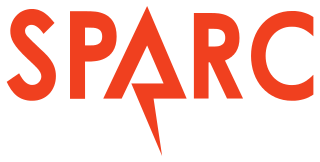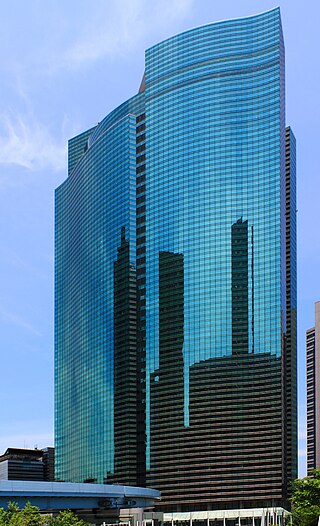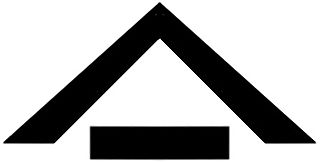
SPARC is a reduced instruction set computer (RISC) instruction set architecture originally developed by Sun Microsystems. Its design was strongly influenced by the experimental Berkeley RISC system developed in the early 1980s. First developed in 1986 and released in 1987, SPARC was one of the most successful early commercial RISC systems, and its success led to the introduction of similar RISC designs from many vendors through the 1980s and 1990s.
AIBO is a series of robotic dogs designed and manufactured by Sony. Sony announced a prototype Aibo in mid-1998, and the first consumer model was introduced on 11 May 1999. New models were released every year until 2006. Although most models were dogs, other inspirations included lion cubs, huskies, Jack Russell terriers, bull terrier, and space explorers. Only the ERS-7, ERS-110/111 and ERS-1000 versions were explicitly a "robotic dog", but the 210 can also be considered a dog due to its Jack Russell Terrier appearance and face. In 2006, AIBO was added into the Carnegie Mellon University Robot Hall of Fame.

A humanoid robot is a robot resembling the human body in shape. The design may be for functional purposes, such as interacting with human tools and environments, for experimental purposes, such as the study of bipedal locomotion, or for other purposes. In general, humanoid robots have a torso, a head, two arms, and two legs, though some humanoid robots may replicate only part of the body, for example, from the waist up. Some humanoid robots also have heads designed to replicate human facial features such as eyes and mouths. Androids are humanoid robots built to aesthetically resemble humans.

Fujitsu Limited is a Japanese multinational information and communications technology equipment and services corporation, established in 1935 and headquartered in Tokyo. Fujitsu is the world's sixth-largest IT services provider by annual revenue, and the largest in Japan, in 2021. The hardware offerings from Fujitsu are mainly of personal and enterprise computing products, including x86, SPARC and mainframe compatible server products, although the corporation and its subsidiaries also offer a diversity of products and services in the areas of data storage, telecommunications, advanced microelectronics, and air conditioning. It has approximately 126,400 employees and its products and services are available in approximately 180 countries.
Scouting in Virginia has a long history, from the 1910s to the present day, serving thousands of youth in programs that suit the environment in which they live. Many of the local groups and districts took names of historic Virginia Indian tribes in the state.

Enon was an indie rock band founded by John Schmersal, Rick Lee, and Steve Calhoon that was active from 1999 to 2011; for most of its history, however, Enon was a three-piece outfit composed of Schmersal, Toko Yasuda, and Matt Schulz. Though situated for a time in Philadelphia, Enon was known for being part of the New York music scene.

FANUC is a Japanese group of companies that provide automation products and services such as robotics and computer numerical control wireless systems. These companies are principally FANUC Corporation of Japan, Fanuc America Corporation of Rochester Hills, Michigan, USA, and FANUC Europe Corporation S.A. of Luxembourg.

Robot welding is the use of mechanized programmable tools (robots), which completely automate a welding process by both performing the weld and handling the part. Processes such as gas metal arc welding, while often automated, are not necessarily equivalent to robot welding, since a human operator sometimes prepares the materials to be welded. Robot welding is commonly used for resistance spot welding and arc welding in high production applications, such as the automotive industry.

A robotic lawn mower is an autonomous robot used to cut lawn grass. A typical robotic lawn mower requires the user to set up a border wire around the lawn that defines the area to be mowed. The robot uses this wire to locate the boundary of the area to be trimmed and in some cases to locate a recharging dock. Robotic mowers are capable of maintaining up to 30,000 m2 (320,000 sq ft) of grass.

In Japan, popular robots include humanoid entertainment robots, androids, animal robots, social robots, guard robots, and many more. Each type has a variety of characteristics.

The FM-7 is a home computer created by Fujitsu. It was first released in 1982 and was sold in Japan and Spain. It is a stripped-down version of Fujitsu's earlier FM-8 computer, and during development it was referred to as the "FM-8 Jr.".

A robotics simulator is a simulator used to create an application for a physical robot without depending on the physical machine, thus saving cost and time. In some case, such applications can be transferred onto a physical robot without modification.
The HOAP series robots are an advanced humanoid robot platform manufactured by Fujitsu Automation in Japan. HOAP is an abbreviation for "Humanoid for Open Architecture Platform".
Kainos Group plc is a software company headquartered in Belfast, Northern Ireland that develops information technology for businesses and organisations. It is listed on the London Stock Exchange and is a constituent of the FTSE 250 Index.

Furukawa Group formerly Furukawa zaibatsu (古河財閥) is one of Japan's 15 largest industrial groups. Its origins date back to 1875, founder Furukawa Ichibei. This group specialized in mining, electronics, and chemicals industry before World War II.
Robot economics is the study of the market for robots. Robot markets function through the interaction of robot makers and robot users. As a factor of production, robots are complements and/or substitutes for other factors, such as labor and (non-robot) capital goods. Another part of robot economics considers the effects of the introduction of robots on the markets for those other factors and on the products that robots help produce.

FUJITSU Cloud IaaS Trusted Public S5 is a Fujitsu cloud computing platform that aims to deliver standardized enterprise-class public cloud services globally. It offers Infrastructure-as-a-Service (IaaS) from Fujitsu's data centres to provide computing resources that can be employed on-demand and suited to customers' needs.
ELOT 927 is 7-bit character set standardized by ELOT, the Hellenic Organization for Standardization (HOS). It is also known as ISO-IR-88, CSISO88GREEK7 or 7-bit DEC Greek. The standard was withdrawn in November 1986. Support for it was implemented in various dot matrix printers and line printers as well as in computer terminals. Support for it can still be found in various applications, languages and protocols today, for example in Perl and Kermit.













